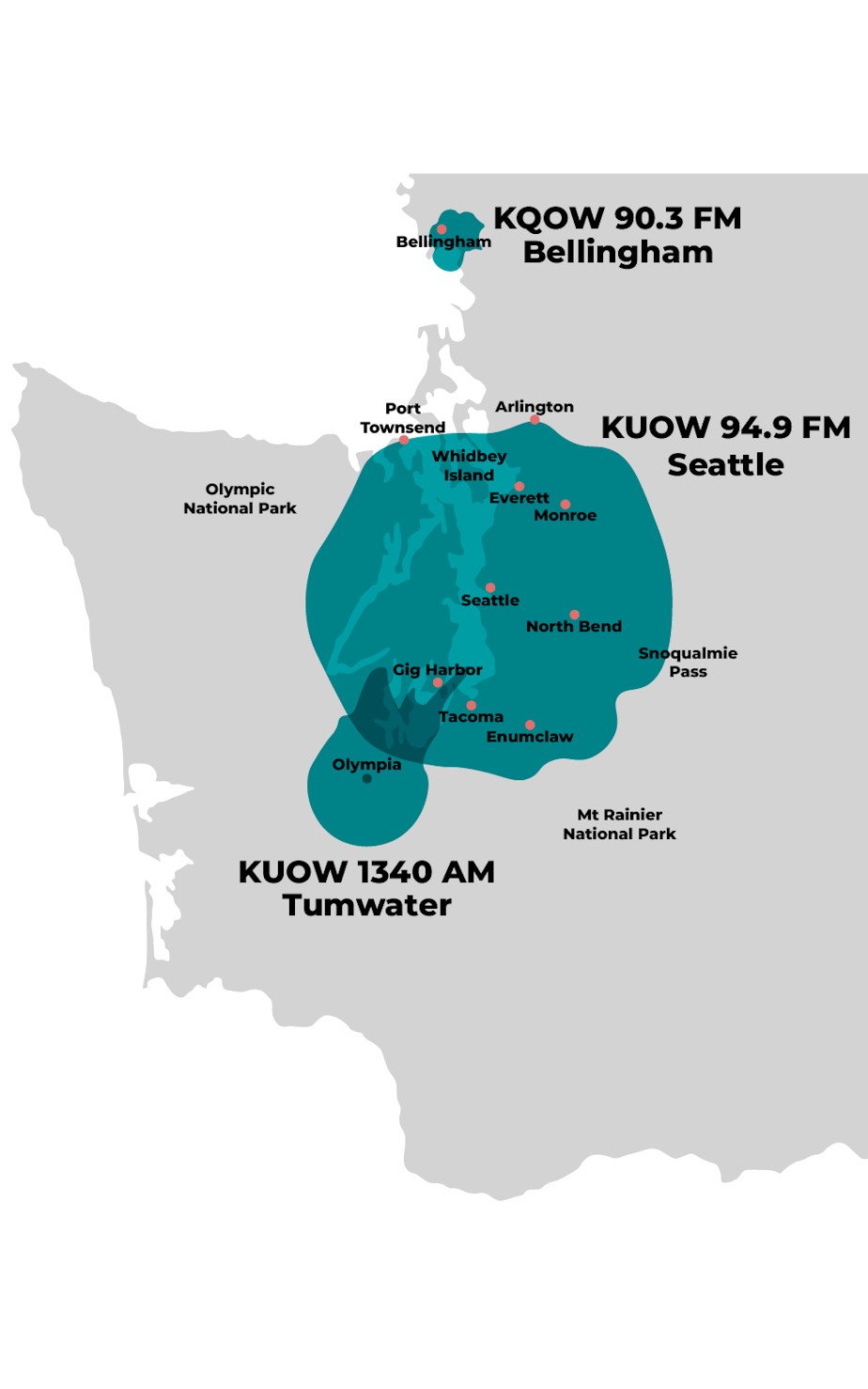Reception Help
KUOW's powerful 100,000 watt signal broadcasting at 94.9 FM originates from our transmitter on Seattle's Capitol Hill and reaches east to the Cascade Mountains, west to the Olympic Mountains, south into Pierce and Thurston counties, and north into Snohomish, Skagit and Island counties.

While much of the Bellingham area is served by KUOW 94.9 FM, some listeners may receive a stronger broadcast from our transmitter, KQOW 90.3 FM. We also transmit the BBC on 90.7 FM and 90.3 HD-2 in Bellingham.
Listeners in Olympia and other communities south into Pacific County may receive KUOW at 94.9 FM and for some, reception may be best at 1340 AM.
Here are common reception issues and solutions for FM and AM. Please note, portable and desktop radios are not all created equal — a good quality receiver really makes a dramatic difference in radio reception.
FM Reception
Below is a list of four common reception problems and possible solutions. For more in–depth help, we recommend the BBC's reception advice.
Weak Signals or Hiss
Adjusting your antenna or moving the radio to another room or near a window often helps. If this doesn't work you may want to get an outdoor antenna or amplifier.
Distortion
Distortion particularly affects consonants S or Z, making them sound like "ssshhh." If you are using a portable radio, try moving it somewhere else. If your radio is attached to an outdoor antenna, try moving that. If you still have problems, try using a directional roof–mounted antenna.
Channel Interference
This is when you hear two channels at the same time. The problem is usually worse in stereo mode than in mono. A directional roof–mounted antenna can often help.
Overloading
Distortion caused by overloading can only happen if you live very close to an FM transmitting station. The cure is to add an "attenuator" between the antenna and the receiver. Attenuators come in various decibel values and are available from radio and TV shops as well as antenna installers.
AM Reception
Atmospheric Interference
AM signals are harder to hear at night than they are in the daytime. Just before sunset until shortly after sunrise, AM signals from other cities can reflect off the upper atmosphere and skip hundreds of miles causing interference to the KUOW 1340AM signal during this time. This problem is usually worse in the winter than it is in the summer. AM signals are also prone to inference by lightning storms.
Technical Interference
AM signals are prone to interference by a variety of technical sources: other radio stations, power lines and computers. Lighting sources also can influence AM reception: Fluorescent lighting and most lighting dimmers are actually little AM radio transmitters and can cause severe interference. AM reception can also be difficult in large buildings due to steel construction, electrical systems and computers.
Ways To Improve Your AM Reception
Car radios generally receive AM radio best. The signal quality does vary somewhat from car to car and is affected by passing under power lines, moving around rocky hills, over bridges or through tunnels. Some car antennas are embedded in the rear window or within the roof of the car – reception in these cars tends to be poor. Try these suggestions for better car reception:
- Manually tune in 1340 AM even if you have an auto scan button on your car radio.
- Be sure the antenna is extended fully.
- Adjust the tone control to reduce treble. This sometimes reduces the power line noise heard on the radio.
- You may want to replace the car antenna with one of higher quality.
For Better Indoor Reception
- Keep the radio away from computers, fluorescent and neon lights – they create noise on the AM radio. Also, most light dimmers in any position except for fully on or fully off will do the same.
- Put the radio near a window — the signal will be the strongest there.
- AM antennas are built into most radios so you may need to move your unit around to get the best signal possible. If your radio has screw connections on the back labeled "AM," consider purchasing or making an external antenna for best reception results. Note: The "post type" antenna that pulls out of the radio is for FM and does nothing for AM reception.
- Built–in AM antennas are directional. Rotate the radio in a 360–degree circle and stop when you get the best reception.
- You may want to add an antenna out–of–doors to make a significant improvement in AM and FM reception.
